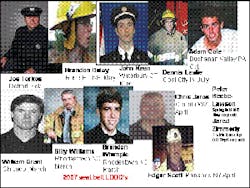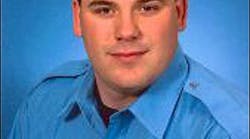Twelve firefighters have died in the line of duty since January 2007, in crashes without having their seat belt on. This must stop. We have no excuse. Almost 50% of firefighters nationwide do not use their seat belt. In some fire departments over 90% do not buckle up. Firefighting is dangerous; not wearing your seat belt if foolish, unprofessional, and in most states illegal. When you don't put your seat belt on, you dishonor all the firefighters who died to get seat belts put in apparatus. Shame on us if we do not fix this problem now.
The phrase hardball usually means that something is serious and effort is being excreted to make change by some type of force. The National Highway Traffic Administration (NHTA) "Click it or Ticket" campaign is just that. They make seat belts a priority for every officer and police agency in the country to give out tickets to everyone who does not have a seat belt on. Just the threat that the seat belt law will be enforced with a fine if you are caught not bucked up has pushed seat belt use to an all-time high of 89% nationwide. With the help of a $10,000,000.00 national advertising campaign and tickets with a fine, the NHTA has played seat belt hardball.
The National Seat Belt Pledge campaign is not hardball. First, there is no money for ads or staff or websites or material. Second, there is no federal agency in charge of firefighter safety much less enforcing the seat belt rules. Third, the fire service, as a culture, does not believe it needs to use seat belts. Fourth, most fire chiefs and fire officer do not enforce their own seat belt rules. Finally, too many firefighters believe that real firefighters cannot use seat belts because another company will steal their fire or a civilian will die because the firefighter will not get out of the apparatus quick enough to save them. (Actual excesses by firefighters)
So far over 40,000 firefighters nationwide have signed the seat belt pledge. Over 80 fire departments have 100% participation in the program and will get a certificate signed by the United States Fire Administration, United States Fire Academy, International Association of Fire Chiefs, National Volunteer Fire Council, National Fire Protection and National Fallen Firefighters Foundation. The program objective is 1,000,000 signatures. The impact objective is that no firefighter will die in 2008 because they did not have their seat belt on.
The Chesapeake, VA, Fire Department, under the direction of Deputy Chief E. E. Elliott, is leading the fire service in demonstrating the commitment to firefighter safety when it come to changing our seat belt culture to insure that everyone goes home. Some times it takes hardball.
Chief Elliott in his own words:
"During the very first National Firefighter Safety Stand-Down, our Department (Chesapeake Fire Department) focused its dialogue specifically toward encouraging and enforcing our existing polices regarding the use of seat belts. During that year's safety campaign, we initiated an internal "Safety Pledge Campaign" of our own. Our members were asked to make a "Pledge" that they would never ride in a vehicle without first buckling their seat belt. Each member making the "Pledge" received a special "Safety Award Certificate" signifying their commitment to driver safety and the safety of the members of their fire company.
This policy has been aggressively enforced over the last three years. Our Safety Officer repeatedly forwards LODD notifications, news articles, photographs of vehicle crashes, and eye-opening video clips to all our members to re-enforce and maintain a high level of safety awareness. After three years of aggressively pushing "change", developing and invoking a solid driving policy, as well as encouraging and mandating the use of seat belts every time a member sits in the seat, one would think this department had attained 100% policy compliance. I did.
Earlier this year, however, I was returned to the real world. Within about the same timeframe, two red flags were raised. First, our Department???s Safety Committee was receiving complaints from some company officers that while filling-in for other officers, they felt like they were the "bad guy" for enforcing the seat belt policy when, apparently, the members of those particular crews had not been adhering to it . The second "red flag", and perhaps the most eye-opening revelation, came about during our bi-annual promotional process. While sitting in the Fire Chief's interview portion of the process, there were candidates who took the absolutely correct position on "leadership by example", and at the same time, openly admitted that they either (1) did not always wear seat belts themselves or (2) did not always ensure that their crew was belted in. I can commend the candidates honesty, however, their responses were the warning signal that we were not where we thought we were.
One of the sixteen Firefighter Life Safety Initiatives now in place, actually the very first one regarding cultural change, places responsibility on leadership. In response to this initiative, we now have a catch phrase aimed at firefighters: "The courage to be safe!" The question should be turned around and pointed to chief officers and fire service leadership. "Do we have the courage to be safe?" Inevitability, our actions speak louder than our words.
My personal commitment to the 2007 Firefighter Safety Stand Down was to ensure, to the best of my ability, that "Everyone in the Chesapeake Fire Department Goes Home!" To that end, I raised the stakes on non-adherence to our standing driver safety policy mandating the use of seat belts.
Effective July 1, 2007, the violation of our policy is now in the most serious category of policy violations; "violation of safety rules where there is a threat of bodily harm." With this revision, non-compliance can now result in the termination of employment for the individual, the driver, and the officer. (This is seat belt hardball!)
As difficult as this action feels for me personally, it is so easy when compared to attending a LODD funeral. Even as we have worked in the past to change fire service culture toward discrimination and harassment, some facts remain the same. There are members of the fire service who will not "get it???"until somebody loses their job; and those firefighters that still don't "get it" should not be associated with the fire service organization.
Chief Officers, there are two questions you need to answer regarding the use of seat belts in your departments. First, do you know the differences that exist between your policies and your practices? Moreover, do you have the courage to do what it takes to bring them into alignment?
The rest of the story...
"On July 3, 2007, two days after the stakes were raised on the mandatory use of seat belts in our department, we experienced an unfortunate, but perhaps, timely incident.
While traveling on a back, rural road, the freshly paved asphalt road surface broke away under the weight of the fire apparatus, lunging the pumper headlong into the ditch (there was absolutely no road shoulder). The engine proceeded to plow the ditch for approximately 60 feet, taking out a telephone pole in the process. Eventually, it came to rest almost on its side with a grass fire now burning close by due to downed power lines. All four members were securely buckled in at the time of the incident and were able to extricate themselves from the engine, walking away with only minor cuts and bruises.
During my personal interview with the company captain, he stated, given the impact to which he was subjected, he shuddered to think what the end result would have been if any one of the four had not been secured in the cab with seat belts.
The Chesapeake Fire Department experience is an excellent example of "Talk softly but carry a big stick." When it comes to firefighter seat belt safety we must hold ourselves and each other accountable. Take the pledge...buckle up...enforce the policy...make the discipline hardball. The alternative is deadly. Firefighters and fire chiefs you choose!
DR. BURTON CLARK EFO, CFO, a Firehouse.com Contributing Editor, is the Management Science Program Chair at the National Fire Academy and serves as an operations chief during national disasters and emergencies for the DHS/FEMA. He was a firefighter in Washington, D.C. and Assistant Fire Chief in Laurel, MD. Burton is the host of Leadership on the Line on Firehouse Podcasts. To read Burton's complete biography and view their archived articles, click here.








